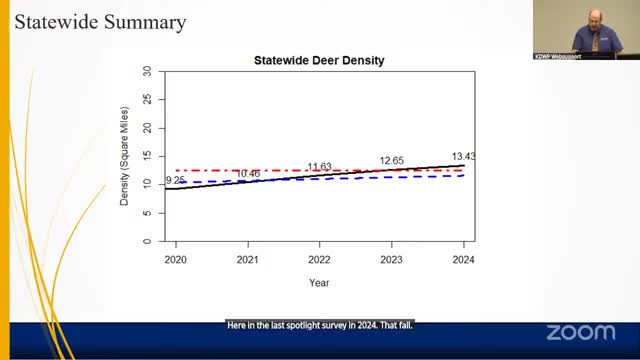Kansas DNR adjusts deer permit quotas amid declining mule deer populations
March 27, 2025 | Department of Wildlife & Parks, State Agencies, Organizations, Executive, Kansas
Thanks to Scribe from Workplace AI , all articles about Kansas are free for you to enjoy throughout 2025!

This article was created by AI using a video recording of the meeting. It summarizes the key points discussed, but for full details and context, please refer to the video of the full meeting. Link to Full Meeting
The commission reported a concerning decline in mule deer numbers in western Kansas, particularly in the 1 and East zones, where spotlight surveys have shown limited observations, making it difficult to estimate overall populations. Factors contributing to this decline include habitat conditions and drought, alongside a high prevalence of chronic wasting disease. In contrast, eastern Kansas has experienced a steady increase in deer populations, with some units reporting upward trends despite a slight dip in recent surveys.
In response to these population trends, the commission proposed changes to the antlerless deer hunting season and permit structure. Western Kansas units will see a reduction in hunting opportunities, with some areas, such as Management Unit 18, having no antlerless permits available. Conversely, eastern units will benefit from extended seasons and increased permit availability, reflecting the healthier deer populations in those regions.
The commission emphasized the importance of managing deer populations sustainably, balancing hunter demand with ecological considerations. The adjustments aim to address concerns from local landowners about crop damage and deer vehicle accidents, while also ensuring fair access to hunting opportunities for residents and non-residents alike.
As the meeting concluded, the commission prepared to move forward with the proposed changes, which will be subject to public input and further review before implementation. The ongoing management of deer populations in Kansas remains a priority, as the state navigates the complexities of wildlife conservation and hunting regulations.
Converted from KDWP Commission Meeting - Thursday, March 27, 2025 meeting on March 27, 2025
Link to Full Meeting
Comments
View full meeting
This article is based on a recent meeting—watch the full video and explore the complete transcript for deeper insights into the discussion.
View full meeting
